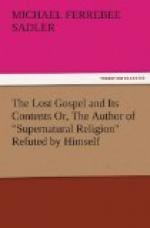Again, St. John is the only Evangelist who, in apparent allusion to the devout and spiritual reception of the Inward Part of the Lord’s Supper, speaks of it as eating the Flesh of Christ, and drinking His Blood; the Synoptics and St. Paul in I Cor. x. 11, always speaking of it as His Body and Blood. Now Justin, in describing the Sacrament of the Lord’s Supper, uses the language peculiar to St. John as well as that of the Synoptics:—
“So likewise have we been taught that the food which is blessed by the prayer of His word, and from which our blood and flesh by transmutation are nourished, is the flesh and blood of that Jesus Who was made flesh. For the Apostles, in the Memoirs composed by them, which are called Gospels, have thus delivered unto us what was enjoined upon them; that Jesus took bread, and when He had given thanks, said, ‘This do ye in remembrance of me. This is my body,’” &c. (Apol. I. ch. lxvi.)
This, of course, would be a small matter itself, but, taken in connection with the adoption of St. John’s language in regard of the other sacrament a very short time before, it is exceedingly significant.
Again, St. John is the only Evangelist who records our Lord’s reference to the brazen serpent as typical of Himself lifted up upon the Cross. Justin cites the same incident as typical of Christ’s Death, and, moreover, cites our Lord’s language as it is recorded in St. John, respecting His being lifted up that men might believe in Him and be saved:—
“For by this, as I previously remarked, He proclaimed the mystery, by which He declared that He would break the power of the serpent which occasioned the transgression of Adam, and [would bring] to them that believe on Him by this sign, i.e., Him Who was to be crucified, salvation from the fangs of the serpent, which are wicked deeds, idolatries, and other unrighteous acts. Unless the matter be so understood, give me a reason why Moses set up the brazen serpent for a sign, and bade those that were bitten gaze at it, and the wounded were healed.” (Dial. ch. xciv.)
Again, St. John is the only Evangelist who records that the Baptist “confessed, and denied not, but confessed, ‘I am not the Christ.’” Justin cites these very-words as said by the Baptist:—
“For when John remained
(or sat) by the Jordan ... men supposed him
to be Christ, but he cried
to them, ’I am not the Christ, but the
voice of one crying,’”
&c. (Dial. ch. lxxxviii.)
Again, St. John is the only Evangelist who puts into the mouth of our Blessed Lord, when He was accused of breaking the Sabbath, the retort that the Jews on the Sabbath Day circumcise a man ... that the law of Moses should not be broken. (John vii. 22) And Justin also reproduces this in his Dialogue:—




